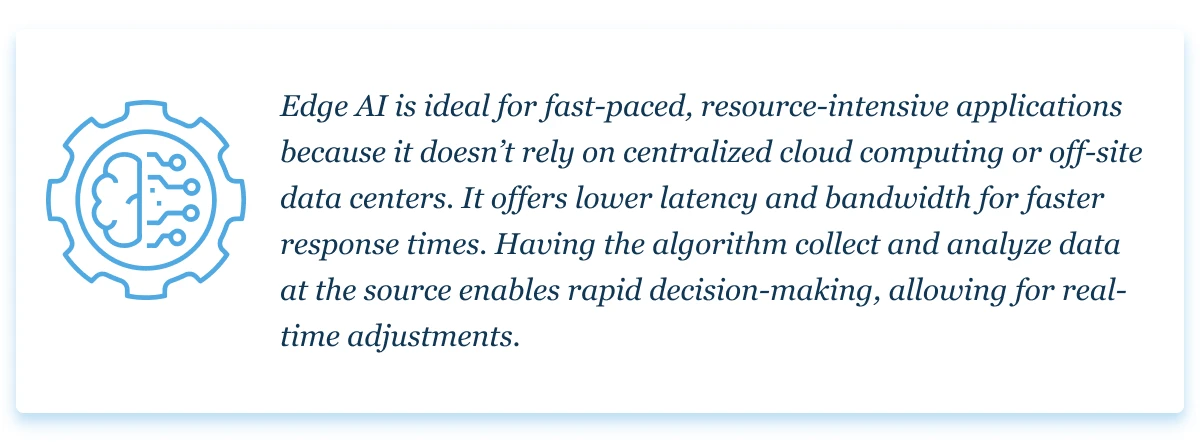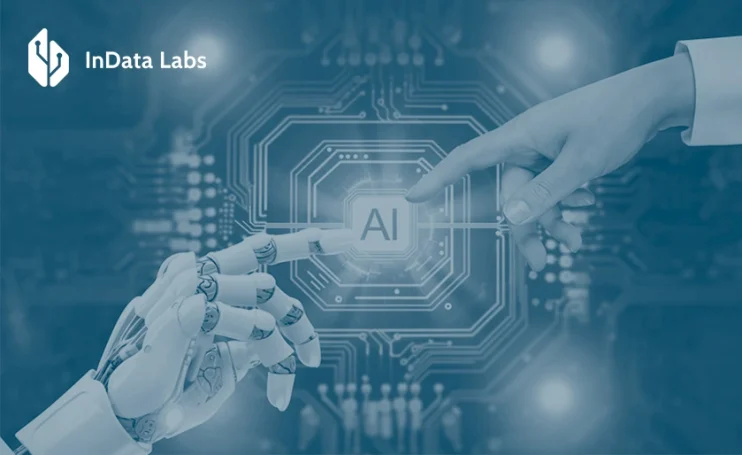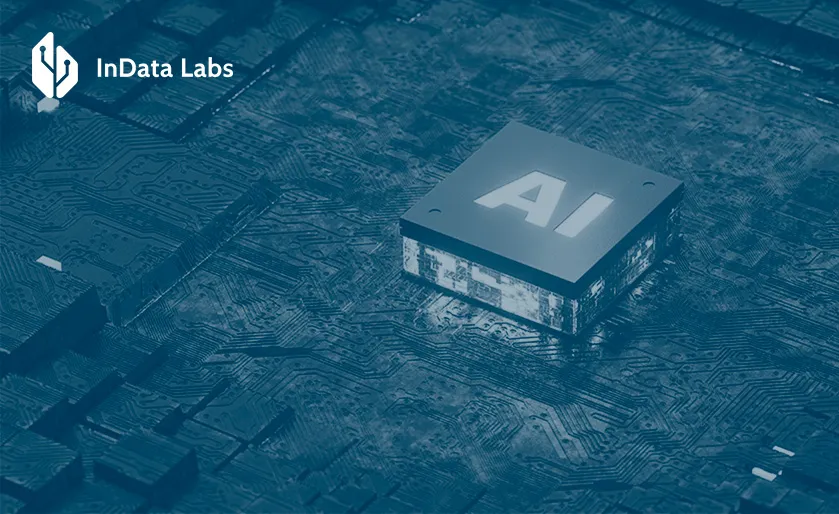Edge artificial intelligence may soon surpass other algorithm types in popularity and performance. While this cutting-edge AI advancement is still in its infancy, global market valuations and steadily increasing implementation rates prove its potential.
Cutting-edge AI is the latest in AI technology
The concept of edge AI came into existence because of edge computing — a decentralized computing framework — so it functions similarly. Unlike machine learning, deep learning or natural language processing, it isn’t a unique model type. Instead, it revolves around the algorithm’s location.
Cutting-edge AI involves deploying a machine learning model at a network’s boundary. Instead of relying on a centralized cloud computing environment or off-site data centers, an embedded algorithm collects and analyzes information directly on or near the device.

Source: Unsplash
Usually, algorithm learning depends on data transfers. Typical cloud AI services train and deploy machine learning models from a centralized infrastructure. While they’re the current standard, edge technology may soon become more popular since it allows local adaptation. It offers an advantage in time-sensitive scenarios.
While AI is cutting edge itself, edge AI promises to be revolutionary. Since it doesn’t rely on internet connectivity and cannot be impacted by a centralized cloud computing environment experiencing downtime, it offers more real-world use cases than conventional algorithms.
Why is edge AI better?
Conventional models have many performance gaps — they require human intervention to understand context, are prone to logical errors and can’t readily see correlations. While cutting-edge artificial intelligence shares many algorithm-inherent issues, it’s far more reliable, accurate, resilient and scalable. For general applications, it is better than other options.

Since the machine learning model at the edge functions in a decentralized environment, it can make subtle adaptations much faster. It doesn’t rely on constant data transfers and can rapidly react to changes. As a result, the algorithm receives continuous performance improvements in a more private, secure setting. The decreased reliance on internet connectivity and a centralized computing infrastructure makes edge AI better.
While AI is cutting-edge, it isn’t as affordable. Deploying and running a machine learning model on a decentralized infrastructure with minimal data transfers is much less expensive. Additionally, its performance enhancements and improved processing can lead to indirect cost savings for businesses.
What can edge AI be used for?
Edge AI is similar to conventional algorithms in that it is highly versatile. Unlike natural language processing or deep learning models, it is easily scalable and readily available. While any industry can adopt it, it is mainly present in the healthcare, retail, consumer technology and transportation sectors.
Cutting-edge AI applications
Many cutting-edge AI companies are beginning to leverage artificial intelligence at the edge in any scenario where data privacy or low latency is critical. Since AI has numerous applications in every industry, businesses quickly discovered relevant use cases. Naturally, they used this technology to fill the gaps conventional algorithms have.
Organizations can use edge AI for any time-sensitive tasks. For instance, healthcare professionals can use it in AI-powered surgical robots or diagnostic computers because its low latency and decreased reliance on internet connectivity guarantee faster response times. Notably, its decentralized nature keeps patients’ personally identifiable information secure.

Source: Unsplash
Data-based forecasting is another example of cutting-edge AI applications. This technology can substantially reduce overhead costs by minimizing downtime, improving productivity, and adapting in real time to schedule shifts. While conventional algorithms can leverage predictive analytics, their response times are slower and may be less accurate.
Businesses can also use machine learning at the edge for rapid media analysis. Since it doesn’t rely on data transfers, it can quickly examine images and videos on-site. This concept applies to AI-powered cameras, facial recognition devices and smartphone photo galleries. It’s helpful in any scenario where an algorithm must quickly interpret visual information.
What is an example of edge AI?
Cutting-edge artificial intelligence has many real-world use cases and applications. Many AI case studies prove the value of leveraging machine learning models at the edge. Moreover, implementation success stories are abundant in sectors like consumer technology, retail, transportation, energy and manufacturing.
Cutting-edge AI tools
This technology has produced many cutting-edge AI tools. AI-powered computer vision is one such example, combining machine learning at the edge with a conventional visual interpretation device results in a robust machine capable of analyzing images and videos on the same device where the data is sourced.
Many industries already use cutting-edge machine-learning tools. For instance, the higher education sector uses automated messaging algorithms to contact students about updates on their academic performance. This real-time communication is far superior to conventional methods since it enables early intervention.

Source: Unsplash
Some tools are simply improvements on other algorithm types. For example, decentralized natural language processing leverages cutting-edge AI deep reinforcement. Consequently, chatbots will respond faster, interpret input better, and react more accurately. This innovation could result in real-time language translation and highly realistic voice assistants.
Cutting-edge AI technology
Transportation businesses can use cutting-edge AI deep reinforcement to make self-driving cars a reality. Since vehicles’ sensors rely on localized machine learning at the edge instead of data transfers to a centralized cloud infrastructure, the algorithm can make real-time adjustments on the road autonomously. This improves safety and performance.

Wearables are another example. While AI-powered Internet of Things (IoT) devices already exist, they have various security and performance gaps. Machine learning at the edge fixes these issues at a reduced cost because it isn’t reliant on data transfers. Consumers then experience low latency, lower bandwidth requirements and secure information collection.
Why use edge AI?
More business opportunities will appear as more cutting-edge AI companies realize edge AI’s potential. It will likely become one of the most prominent technology trends across numerous industries as rapidly increasing adoption rates spur innovation. Whether someone is an aspiring entrepreneur or a midsized business owner, they can benefit from its implementation.
Future market trends
Already, market trends suggest artificial intelligence at the edge will reach a tremendous value. The market is projected to grow from USD 27.01 billion in 2024 to USD 269.82 billion by 2032, exhibiting a CAGR of 33.3% during the forecast period.

Source: Unsplash
While the consumer technology sector will undoubtedly drive massive revenue, business acceptance also seems promising. Considering most organizations have already implemented AI to some extent, they will likely readily adopt this improved technology after it exits its proof-of-concept stage and becomes a sure investment.
While edge AI adoption rates may seem relatively low compared to other similar algorithm types, they will undoubtedly skyrocket soon. It will likely become one of the top trending technologies worldwide in a few years.
Business opportunities
Aside from the allure of promising market trends, startups, and midsized businesses should consider implementing edge AI because it offers numerous opportunities. This responsive, adaptive technology guides proactive business decisions, adapts to changing market conditions, and helps solve issues rapidly and privately.
Already, organizations leverage artificial intelligence and machine learning for cutting-edge problems. An AI implementation strategy becomes paramount as a growing number adopt this technology. Carefully considered, realistic implementation expectations will reveal more business opportunities and improve outcomes.
What is leading edge AI?
Edge AI first appeared in the early 2020s as an inevitable advancement of edge computing. Since then, state-of-the-art research and development have propelled it into new areas. Further exploration becomes increasingly crucial as the amount of mobile and IoT devices expands while existing cloud computing solutions remain the same.
Cutting-edge AI research
Currently, much cutting-edge AI research revolves around computational resources. This technology is still in the early implementation stages, so proactive action is essential for future commercial viability. For instance, the widespread use of edge AI smartphone chips requires seamless, energy-efficient computational offloading to preserve phones’ functionality.
Other AI cutting-edge research revolves around developing premade software and hardware. Whether businesses want AI-powered surveillance systems or wearables for their employees, they must build their tools from the ground up or hire a third party to do it for them. Since AI at the edge is still in its infancy, very few off-the-shelf solutions are available. Soon, more AI companies will invest heavily in their creation to gain a competitive advantage. Consequently, they must address existing hardware limitations to make up for resource-intensive computational processes.

Source: Unsplash
Is edge AI the future?
Deploying devices at the edge with AI ensures better performance at lower costs. While further research and development is necessary to find widely applicable, commercially viable implementation solutions, this technology will soon become popular across numerous industries. Market estimations show it will perform exceptionally well in the coming years.
Since edge computing will see substantial market growth, edge AI will likely follow suit. Experts project its global value will increase from $153 billion in 2020 to $317 billion by 2026 — more than doubling in less than a decade — which looks promising for the future of the technology.
However, while cutting-edge AI shows promise, its current adoption rate isn’t as high as machine learning, natural language processing, or deep learning. Moreover, its market value estimates somewhat rely on the popularity of edge computing and various model types.
Companies must achieve successful implementation if edge technology is going to surpass similar algorithms to become the future of AI-powered devices. Since business outcomes improve with AI consulting, third-party assistance should be a serious consideration. This way, startups, entrepreneurs, and even midsized businesses can follow the guidance of people with subject-matter expertise to identify realistic goals and prove the tool’s viability.
While edge AI’s commercial viability and operational use cases may not seem as robust as similar technologies, they soon will be. These innovations will likely pave the way for future algorithmic advancements, prompting companies to develop state-of-the-art devices for consumer and business applications.
When will edge AI become widespread?
Edge AI may be relatively recent, but it is catching on quickly. If market value estimations and adoption rate statistics are accurate, its popularity will likely rapidly spike within a few years. While there’s no guarantee it can outperform similar technologies, there’s a strong chance it will.

Source: Unsplash
For the most part, AI at the edge will be business-centered because it offers cost-effective efficiency gains. While consumers will reap the benefits of low latency and fast processing in chatbots, voice assistants, IoT wearables, and photo analysis, the difference in speed is relatively insignificant to them.
Startups and midsized businesses will drive edge AI adoption. While they should expect the technology to become widespread in a few years, the true timeline is ultimately up to them. If they embrace it, they will streamline its widespread implementation and time to market.
Edge AI is the future of AI-powered technology
Industry experts and researchers have proven edge AI’s cutting-edge capabilities. Its accuracy, speed, and performance are far better than conventional models. Moreover, its versatility is unparalleled — it has use cases for every sector, from consumer technology to health care. These marked improvements will soon make it one of the most sought-after technologies.



